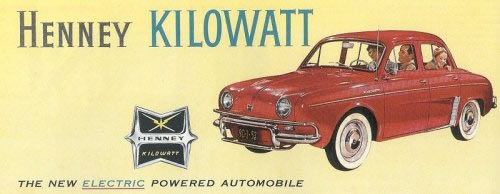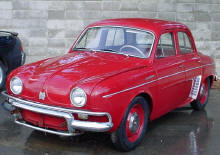 The Henney Kilowatt was an
electric car introduced for the 1959 model year.
The Henney Kilowatt was an
electric car introduced for the 1959 model year.
Corporate funding
The Henney Kilowatt was a project of
National Union Electric Company, a conglomerate including
Emerson Radio, and Henney Motor Company, which had purchased Eureka
Williams in 1953. The project was initiated by
C. Russell Feldmann, president of National Union
Electric Company and the Eureka Williams Company. To build the electric
cars, he employed the services of the
Henney Motor Company coachwork division of
Canastota, New York. Henney had been building custom coaches since
1868 and was a well-recognized name in the automotive industry because
of its affiliation with the Packard
Automobile Company. Henney produced thousands of custom built
limousines, ambulances, and hearses (most of them built on Packard
chassis), before being contracted to begin the Kilowatt project.
National Union Electric Company was also the producer of Exide Batteries
—and naturally had a vested interest in shifting American automotive
focus from fossil fuels to lead-cell batteries. Morrison McMullan, Jr.,
controller of Exide Batteries, was also a participant in the development
of the Kilowatt. (In 1974, National Union Electric was purchased by AB
Electrolux of Sweden .)
Designers and
developers
The propulsion system was developed in consultation with
Victor Wouk, then an electrical engineer at
Caltech. Wouk is best known as one of the pioneers of
hybrid electric cars.
Wouk recruited
Lee DuBridge, then President of Caltech, and
Linus Pauling to assist in the assessment and development of the
electronics. Although Pauling never did any
active work on the project, DuBridge convened a group of Caltech experts
to provide input. Wouk designed the necessary speed controller for the
Kilowatt, although the controller was actually manufactured for the
Kilowatts by Curtis Instruments. The electric propulsion system for the
cars was designed and built by the Eureka Williams Company of
Bloomington, Illinois, manufacturer of
Eureka Vacuum Cleaners. Henney Coachworks was contracted to build
the chassis of the car from tooling and parts purchased from Renault.
Many body panels and interior components of the car are virtually
identical to those of the Renault
Dauphine.
Performance
and Technology

A 1960 Kilowatt.
The 1959 models all ran on a 36-volt system of 18 sequential two-volt
batteries. The 36-volt cars had a top speed of 40 mph (64 km/h) and
could run approximately 40 miles (64 kilometres) on a full charge. After
the 36-volt system was realized to be impractical, the Kilowatt
drivetrain was redesigned by Eureka Williams as a 72-volt system for the
1960 model year. It employed 12 sequential six-volt batteries. The
72-volt models were much more practical than the 1959 36-volt models.
The 1960 Kilowatt boasted a top speed of nearly 60 mph (97 km/h) with a
range of over 60 miles (97 kilometres) on a single charge.
Although the Kilowatt is described by some sources as "the first
transistor-based electric car",
the speed controller uses a combination of relays and diodes to switch
the batteries and motor windings in different configurations for
different speeds, not transistors.
Production and sales
According to the official
Eureka Company corporate history profile there were a total of 100
Henney Kilowatts manufactured during the entire two year production run,
but of those 100 cars only 47 were ever sold. A French Renault Dauphine
enthusiast
website also states that a total of 100 rolling chassis were
prepared by Henney Coachworks for the project, but of those only 47
functional cars were actually completed. A March 20, 1967, article in
U.S. News & World Report states that 35 of the Henney Kilowatts
were purchased by electric utilities in the United States. Company
records show that there were 24 cars sold to electric utilities as 36
volt 1959 models and 8 Kilowatts sold to utility companies as 72 volt
1960 models. From these and other sources, it is reasonable to conclude
that fewer than 15 Henney electric cars were actually sold to the
general public. Some of these cars may have been sold as 1961 models.
The company continued promoting the Kilowatt in 1961 with hopes of
securing enough prepaid orders to finish the remaining chassis
components that had already been built. Few, if any, were sold in this
manner. Although the 72 volt propulsion system introduced for the 1960
model year was substantially superior to the earlier 36 volt systems,
Eureka Williams was unable to produce the 72-volt system cheaply enough
or quickly enough to attain the targeted $3600 sales price.
Of the documented 32 Henney Kilowatts produced, it is estimated that
there are between four and eight still in existence. The very first two
Henney Kilowatts - the serial number 0001 car and the original prototype
(serial number "EXPERIMENTAL") were stored by company executives for
decades until being sold to a private U.S. automobile collector in the
early 2000s. These two cars both have fewer than 500 miles (about 800
kilometres) and are impeccable examples of this historical vehicle.
Additionally, there are at least two other documented "survivors" that
are still driven periodically.
Significance
The Kilowatt has been called the world's first
mass production
electric car,
although early in the 20th century electric vehicles were produced in
much larger numbers (thousands per year) by companies such as
Detroit Electric and
Milburn. Although electric cars outsold
gasoline cars in 1900, the introduction of the Kilowatt
followed a period in which they had been out of favor.


